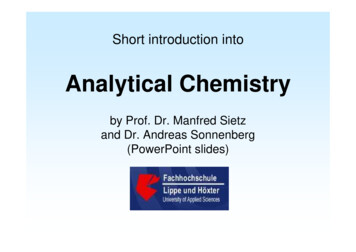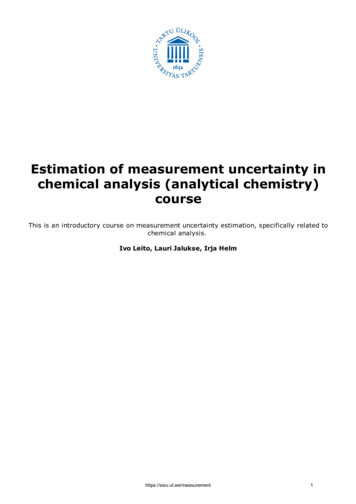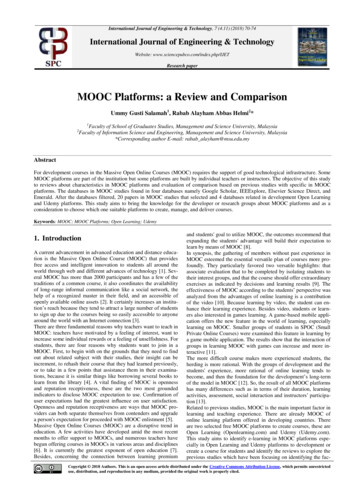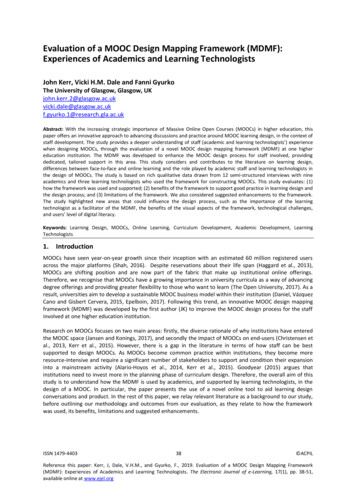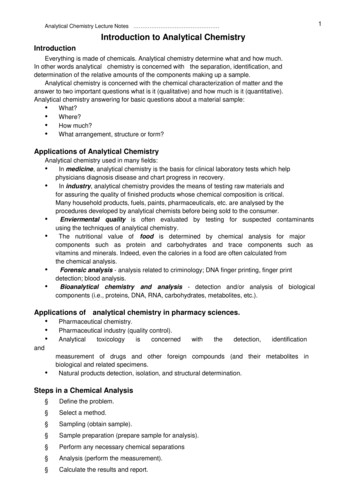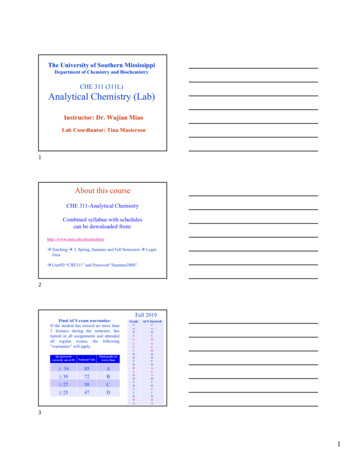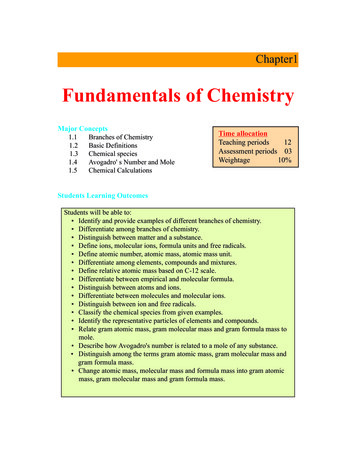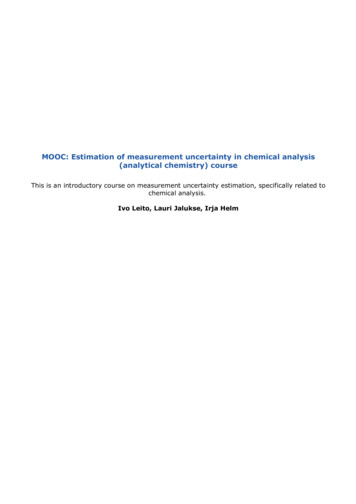
Transcription
MOOC: Estimation of measurement uncertainty in chemical analysis(analytical chemistry) courseThis is an introductory course on measurement uncertainty estimation, specifically related tochemical analysis.Ivo Leito, Lauri Jalukse, Irja Helm
Table of contents1. The concept of measurement uncertainty (MU)2. The origin of measurement uncertainty3. The basic concepts and tools3.1. The Normal distribution3.2. Mean, standard deviation and standard uncertainty3.3. A and B type uncertainty estimates3.4. Standard deviation of the mean3.5. Rectangular and triangular distribution3.6. The Student distribution4. The first uncertainty quantification4.1. Quantifying uncertainty components4.2. Calculating the combined standard uncertainty4.3. Looking at the obtained uncertainty4.4. Expanded uncertainty4.5. Presenting measurement results4.6. Practical example5. Principles of measurement uncertainty estimation5.1. Measurand definition5.2. Measurement procedure5.3. Sources of measurement uncertainty5.4. Treatment of random and systematic effects6. Random and systematic effects revisited7. Precision, trueness, accuracy8. Overview of measurement uncertainty estimation approaches9. The ISO GUM Modeling approach9.1. Step 1– Measurand definition9.2. Step 2 – Model equation9.3. Step 3 – Uncertainty sources9.4. Step 4 – Values of the input quantities9.5. Step 5 – Standard uncertainties of the input quantities9.6. Step 6 – Value of the output quantity9.7. Step 7 – Combined standard uncertainty9.8. Step 8 – Expanded uncertainty9.9. Step 9 – Looking at the obtained uncertainty10. The single-lab validation approach10.1. Principles10.2. Uncertainty component accounting for random effects10.3. Uncertainty component accounting for systematic effects10.4. Roadmap10.5. Determination of acrylamide in snacks by LC-MS11. Comparison of the approaches12. Comparing measurement results13. Additional materials and case studies13.1. Different analytical techniques13.2. Measurement uncertainty estimation in dissolved oxygen determination
13.3. Coulometric KF titration14. Tests and ExercisesFrequently asked questions
Course introductionThis course is offered as a MOOC (Massive Open Online Course) duringMarch 24 – May 05, 2020.Course introductionThis is an introductory course on estimation of measurement uncertainty, specifically related tochemical analysis (analytical chemistry). The course gives the main concepts and mathematicalapparatus of measurement uncertainty estimation and introduces two principal approaches tomeasurement uncertainty estimation – the ISO GUM modeling approach (the “bottom-up” ormodeling approach) and the single-lab validation approach as implemented by Nordtest (the “topdown” or Nordtest approach). The course contains lectures, practical exercises and numerous testsfor self-testing.Course introductionhttp://www.uttv.ee/naita?id 17710https://www.youtube.com/watch?v r34Y-gzf62YIn spite of being introductory, the course intends to offer sufficient knowledge and skills forcarrying out uncertainty estimation for most of the common chemical analyses in routinelaboratory environment. The techniques for which there are examples or exercises include acidbase titration, Kjeldahl nitrogen determination, UV-Vis spectrophotometry, atomic absorptionspectroscopy and liquid chromatography mass spectrometry (LC-MS). It is important to stress,however, that for successful measurement uncertainty estimation experience (both in analyticalchemistry as such and also in uncertainty estimation) is crucial and this can be acquired onlythrough practice.The materials of this course can also be useful for people who do not intend to follow the fullcourse but only want to find answers to some specific questions.This course has been described in the paper: I. Leito, I. Helm, L. Jalukse. Using MOOCs forteaching analytical chemistry: experience at University of Tartu. Anal. Bioanal. Chem. 2015, DOI:10.1007/s00216-014-8399-y.On May 14, 2019 the 6th edition of the course finished successfully. Altogether 590 peopleregistered from 86 countries. 381 participants actually started the course (i.e. tried at least onegraded test at least once) and out of them 238 successfully completed the course. The overallcompletion rate was 40%. The completion rate of participants who actually started the studies was62%. (Some more statistics).You can have a preview of the MOOC in Moodle environment as a guest. Guest access allows youto view the course contents, but you cannot read the forums and take quizzes.Required preliminary knowledgeIntroductory level knowledge of analytical chemistry is required. More advanced knowledge ofanalytical chemistry and introductory knowledge of mathematical statistics is anadvantage. Fluency with and access to a spreadsheet software package (MS Excel, OpeOffice, etc)is highly recommended.Why is measurement uncertainty importanthttp://www.uttv.ee/naita?id 17711https://www.youtube.com/watch?v tn2DLYA72DkStudy outcomes
The student who has successfully passed the course knows:the main concepts related to measurement results and measurement uncertainty, includingtheir application to chemical analysis;the main mathematical concepts and tools in uncertainty estimation;the main measurement uncertainty sources in chemical analysis;the main approaches for measurement uncertainty estimation.The student who has successfully passed the course is able to:decide what data are needed for uncertainty estimation, understand the meaning of theavailable data and decide whether the available data are sufficient;select the uncertainty estimation approach suitable for the available data;quantify the uncertainty contributions of the relevant uncertainty sources using theavailable data;carry out estimation of uncertainty using the main approaches of uncertainty estimation.Organization of the course materialThe course (overall volume 1 ECTS) is organized in 12 sections, of which some are in turn splitinto smaller subsections. The following parts are found in the sections:1. The sections (and also many subsection) start with a brief introduction stating the maintopic(s) and study outcomes of the section.2. The main topic of the respective section is explained in a short video lecture.3. The lecture is followed by a textual part. This text is in most cases meant to complement,not substitute the lecture (although in some cases the contents of the lecture are alsorepeated in some extent). It rather gives additional explanations and addresses someadditional topics that were not covered by the lecture.4. Most sections end with a self-test, which enables to test the acquired knowledge and skills.The tests contain questions, as well as calculation problems. The self-tests are on one handmeant for the students to monitor his/her progress. On the other hand, however, they alsopromote thinking and provide (by the feedback of the questions) additional knowledge aboutmeasurement uncertainty estimation in different practical situations. So, the self-tests are anintrinsic component of the course and it is strongly recommended to take all of them.If you consistently get a message "Server not found" when attempting to watch videos then withhigh probability the reason is the firewall of your local network. The local network administratorsshould enable outcoming connections from your network via port 1935. More specifically it isnecessary to access the server rtmp://flash.ut.ee:1935.An additional possibility is to watch the videos in YouTube via channel "ESTIMATION OFMEASUREMENT UNCERTAINTY IN CHEMICAL ANALYSIS".Direct link: https://www.youtube.com/channel/UCeNhxB WuTDNcbNHFxsBjUwSelf-testingThroughout the course there are numerous self-tests for enabling the student to test his/herknowledge and skills in specific topics. Each test is graded as a percentage (100% correspondingto correctly answering all questions and correctly solving all problems).Explanatory feedback is displayed when wrong answer is selected. All self-tests can be taken asmany times as needed and the success of taking self-tests will not influence the final grade. Werecommend that you take all the self-tests and work with them until you achieve score 100% andonly then move to next topic.Course organization
During the six-week course period the work will be organized using the Moodle onlineenvironment. For every week a set of tasks will be given - which sections of the material epassedat https://sisu.ut.ee/measurement/uncertainty. The self-tests can be taken unlimited number oftimes (preferably, until the answers/solutions are fully correct) and their outcomes will notinfluence the final grade. At the end of each week there will be a graded interim test (in theMoodle environment), which will be counted for assigning the final grade. The participants canchoose themselves how they spend their time during the course, because all graded tests areavailable from the beginning of the course until the end of the course. This enables them toorganize their time the way that is best suitable for them. Please note, however, that the difficultylevel of the tests increases as the course progresses: tests 3-4 are more difficult than 1-2 andtests 5-6 are still more difficult. Because of the higher difficulty level it may be a good idea youmight have to plan more time for the last weeks of the course. How much time it takes for passingthe course, is very individual, but we estimate that an average participant needs 3-4 h per week.Terminology and definitionsWherever possible, the used terminology adheres to the 3rd edition of the International vocabularyof metrology — Basic and general concepts and associated terms (VIM), [1] referred to as “VIM”throughout the course. However, in the interest of better understanding and in order to stress themost important aspects of concepts, in many cases concepts are introduced by definitions that aresomewhat simplified compared to the VIM. More deeply interested students are encouraged toconsult the VIM.If you would like to learn more try(https://www.analyticalchemistry.eu/) Erasmus Mundus master’s programme, which offerseducation in all aspects of Analytical chemistry, including metrology in chemistry (measurementuncertainty, method validation, reference materials, etc), as well as economic and legal aspects ofchemical analysis.This course is run within the framework of the Estonian Center of Analytical Chemistry with theaim of offering easily accessible knowledge in analytical chemistry to labs and industries in Estoniaand elsewhere.Main literature sources [2](1) JCGM 200:2012, International vocabulary of metrology — Basic and general conceptsand associated terms (VIM), 3rd edition. BIPM, IEC, IFCC, ILAC, ISO, IUPAC, IUPAP andOIML, 2012. Available on-line from l(2) JCGM 100:2008 Evaluation of measurement data — Guide to the expression ofuncertainty in measurement. JCGM, 2008. Available on-line .html(3) Quantifying Uncertainty in Analytical Measurement, 2nd ed.; Ellison, S. L. R.; Williams,A., Eds.; EURACHEM/CITAC, 2012. Available on-line des(4) Measurement Uncertainty Revisited. Eurolab Technical Report No 1/2007. Eurolab,2007. Available on-line from http://www.eurolab.org/documents/1-2007.pdf(5) Handbook for Calculation of Measurement Uncertainty in Environmental Laboratories. B.Magnusson, T. Näykki, H. Hovind, M. Krysell. Nordtest technical report 537, ed. 3.1.Nordtest, 2012. Available on-line from s/ ion-3.html(6) Analytical Measurement: Measurement Uncertainty and Statistics. Eds: N. Majcen, V.Gegevicius. EC-JRC IRMM, 2012. Available on-line from
e teamIvo Leito, professor of analytical chemistry at University of Tartu.Ivo teaches analytical chemistry and metrology in chemistry at all study levelsand organizes short training courses for practitioners on different topics ofanalytical chemistry and metrology in chemistry. His research work embraces awide area of topics ranging from studies of superacids and superbases to LC-MSanalysis. He is the initiator of the master’s programme Applied MeasurementScience at University of Tartu.Lauri Jalukse, research fellow in analytical chemistry at University of Tartu.Lauri teaches analytical chemistry and metrology in chemistry at all study levels.He is continuously introducing innovative and active learning approaches intoteaching. His research work is focused on metrological studies of electrochemicaland optical sensors, measurements of dissolved oxygen concentration andmoisture content, as well as organization of interlaboratory comparisons.Irja Helm, research fellow in analytical chemistry at Universityof Tartu.Irja teaches practical classes of analytical chemistry. She takescare that metrological concepts and approaches are introducedto students at as early stage of analytical chemistry studies aspossible.Technical design: Educational Technology Centre, University ofTartu.Contact and feedbackIvo LeitoUniversity of TartuInstitute of ChemistryRavila 14a, Tartu 50411ESTONIATel: 372-5 184 176e-mail: ivo.leito@ut.eeSkype: leitoivoCopyrightThis learning object is protected by copyright under the copyright law of the Republic of Estonia.Proprietary rights belong to the University of Tartu. It is allowed to reproduce, distribute andperform the learning object in public only for learning and teaching. The learning object can beused only as a whole, except in the case of citation. The learning object cannot be used forcommercial purposes and all usage has to be accompanied by a sufficient acknowledgement. It isnot allowed to modify or make an adaptation of the learning object.***[1] JCGM 200:2012, International vocabulary of metrology — Basic and general concepts andassociated terms (VIM), 3rd edition. BIPM, IEC, IFCC, ILAC, ISO, IUPAC, IUPAP and OIML, 2012.Available on-line from l[2] This list of literature references is selecive, not exhauxtive. The references were selected basedon the following criteria: (1) Widely used and cited; (2) useful under practical lab conditions (i.e.not too deeply scientific); (3) a fairly recent version is available and (4) the document is preferably
available free of charge on the Internet. These references are referred to in the course viasuperscript numbers in round brackets, e.g.: VIM(1).
1. The concept of measurement uncertainty (MU)Brief summary: This section introduces the concepts of measurand, true value, measuredvalue, error, measurement uncertainty and probability.The concept of measurement uncertaintyhttp://www.uttv.ee/naita?id 17583https://www.youtube.com/watch?v BogGbA0hC3kMeasurement is a process of experimentally obtaining the value of a quantity. The quantity thatwe intend to measure is called measurand. In chemistry the measurand is usually the content(concentration) of some chemical entity (molecule, element, ion, etc) in some object. Thechemical entity that is intended be determined is called analyte. Measurands in chemistry can be,for example, lead concentration in a water sample, content of pesticide thiabendazole in an orangeor fat content in a bottle of milk. In the preceding example lead (element), ascorbic acid(molecule) and fat (group of different molecules) are the analytes. Water, orange and milk areanalysis objects (or samples taken from analysis objects).In principle, the aim of a measurement is to obtain the true value of the measurand. Every effortis made to optimize the measurement procedure (in chemistry chemical analysis procedure oranalytical procedure [1] ) in such a way that the measured value is as close as possible to the truevalue. However, our measurement result will be just an estimate of the true value and the actualtrue value will (almost) always remain unknown to us. Therefore, we cannot know exactly hownear our measured value is to the true value – our estimate always has some uncertaintyassociated with it.The difference between the measured value and the true value is called error. Error can haveeither positive or negative sign. Error can be regarded as being composed of two parts – randomerror and systematic error – which will be dealt with in more detail in coming lectures. Like thetrue value, also the error is not known to us. Therefore it cannot be used in practice forcharacterizing the quality of our measurement result – its agreement with the true value.The quality of the measurement result, its accuracy, is characterized by measurementuncertainty (or simply uncertainty), which defines an interval around the measured valueCMEASURED, where the true value CTRUE lies with some probability. The measurement uncertainty Uitself is the half-width of that interval and is always non-negative. [2] The following scheme(similar to the one in the lecture) illustrates this:
Scheme 1.1. Interrelations between the concepts true value, measured value, error anduncertainty.Measurement uncertainty is always associated with some probability – as will be seen in the nextlectures, it is usually not possible to define the uncertainty interval in such a way that the truevalue lies within it with 100% probability.Measurement uncertainty, as expressed here, is in some context also called the absolutemeasurement uncertainty. This means that the measurement uncertainty is expressed in thesame units as the measurand. As will be seen in subsequent lectures, it is sometimes more usefulto express measurement uncertainty as relative measurement uncertainty, which is the ratioof the absolute uncertainty Uabs and the measured value y:(1.1)Relative uncertainty is a unitless quantity, which sometimes is also expressed as per cent.Measurement uncertainty is different from error in that it does not express a difference betweentwo values and it does not have a sign. Therefore it cannot be used for correcting themeasurement result and cannot be regarded as an estimate of the error because the error has asign. Instead measurement uncertainty can be regarded as our estimate, what is the highestprobable absolute difference between the measured value and the true value. With high probabilitythe difference between the measured value and the true value is in fact lower than themeasurement uncertainty. However, there is a low probability that this difference can be higherthan the measurement uncertainty.Both the true value and error (random and systematic) are abstract concepts. Their exact valuescannot be determined. However, these concepts are nevertheless useful, because their estimatescan be determined and are highly useful. In fact, as said above, our measured value is an estimateof the true value.***[1] Analytical chemists mostly use the term „analytical method“. In this course we use the term„procedure“ instead of „method“, as this usage is supported by the VIM.[2] Here and in the lecture the capital U is used to denote a generic uncertainty estimate. Thesymbol U is picked on purpose, because expanded uncertainty (generally denoted by capitalU ) fits very well with the usage of uncertainty in this section. However, it is not explicitly calledexpanded uncertainty here, as this term will be introduced in later lectures.
2. The origin of measurement uncertaintyBrief summary: Explanation, on the example of pipetting, where measurement uncertaintycomes from. The concept of uncertainty sources – effects that cause the deviation of themeasured value from the true value – is introduced. The main uncertainty sources of pipetting areintroduced and explained: repeatability, calibration, temperature effect. Explanation of random andsystematic effects is given. The concept of repeatability is introduced.The first video demonstrates how pipetting with a classical volumetric pipette is done and explainswhere the uncertainty of the pipetted volume comes from.Why measurement results have uncertainty? The concept of uncertainty source explained on theexample of pipettinghttp://www.uttv.ee/naita?id 17577https://www.youtube.com/watch?v ufWJB9orWdUThe second video demonstrates pipetting with a modern automatic pipette and explains theuncertainty sources in pipetting with an automatic pipette [1] .Measurement uncertainty sources of pipetting with an automatic pipettehttp://www.uttv.ee/naita?id 18164https://www.youtube.com/watch?v hicLweJcJWYMeasurement results have uncertainty because there are uncertainty sources (effects that causeuncertainty). These are effects that cause deviations of the measured value from the truevalue. [2]If the used measurement procedure is well known then the most importantuncertainty sources are usually also known. Efforts should be made to minimize and, if possible,eliminate uncertainty sources by optimizing the measurement procedure (analysis procedure). Theuncertainty sources that cannot be eliminated (and it is never possible to eliminate all uncertaintysources) have to be taken into account in uncertainty estimation.The magnitudes of the deviations caused by uncertainty sources are usually unknown and in manycases cannot be known. Thus, they can only be estimated. If we can estimate the magnitudes ofall important uncertainty sources then we can combine them and obtain the estimate ofmeasurement uncertainty, which in this case will be called combined measurementuncertainty. How this combining is mathematically done, will be demonstrated in the cominglectures.If we make a number of repeated measurements of the same measurand then ideally all theserepeated measurements should give exactly the same value and this value should be equal to thetrue value of the measurand. In reality the results of the repeated measurements almost alwaysdiffer to some extent and their mean value also usually differs from the true value. Theuncertainty sources cause this. In a somewhat simplified way the uncertainty sources (or effects)can be divided into random effects and systematic effects. [3]The following schemeillustrates this (green circles denote true values, yellow circles denote measured values):
Scheme 2.1. The influence of random and systematic effects on measurementuncertainty.Random effects cause the difference between the repeated measurement results (and thus,obviously, also from the true value). However, if a large number of repeated measurements aremade then the mean value will have little influence from the random effects (situation 2 on thescheme). So, the influence of random effects can be decreased by increasing the number ofrepetitions. Systematic effects cause deviation of all measurements in the series into the samedirection by the same magnitude. [4] Increasing the number of repetitions does not enabledecreasing their influence (situation 3 on the scheme).In principle it is desirable to determine the magnitude and direction of the systematic effects andcorrect the measurement results for the systematic effects. However, it can often be so difficultand work-intensive, that it becomes impractical. Therefore in many cases, rather than accuratelydetermining the systematic effects and correcting for them their possible magnitudes is estimatedand are taken into account as uncertainty sources. In lectures 5.4 and 6 random and systematiceffects are treated more comprehensively.There are in general four main sources of uncertainty in volumetric measurements, i.e.measurements by pipettes, burettes, measuring cylinders and volumetric flasks:Uncertainty due to the non-ideal repeatability of measurement (often calledrepeatability uncertainty). In the case of pipetting this means that however carefully wetry to fill and empty the pipette, we will nevertheless every time get a slightly differentvolume. This is sometimes referred to as the “human effect” or the “human factor”, but infact, if a machine would do the pipetting then there would also be difference between thevolumes (although probably smaller). Repeatability is a typical random effect andcontributes to uncertainty with glass pipettes as well as with automatic pipettes. Itsinfluence on the measurement result can be decreased by making repeated measurementsbut it can never be entirely eliminated.Uncertainty due to calibration of the volumetric equipment (often called calibrationuncertainty). In the case of volumetric glassware this is the uncertainty in the positions ofthe marks on the volumetric glassware. In the case of automatic pipettes this uncertainty iscaused by the systematically too high or too low displacement of the piston inside thepipette. In the case of a given pipette it is a typical systematic uncertainty source. Thisuncertainty source can be significantly reduced by recalibrating the pipette in the laboratoryby the person who actually works with it. Accurate weighing of water at controlled
temperature is the basis of calibration of volumetric instruments and also the way howusually the repeatability uncertainties of different volumetric instruments are found.Uncertainty due to the temperature effect (often called as temperature uncertainty). Allvolumetric ware is usually calibrated at 20 C and volumes usually refer to volumes at 20 C. The density of the liquid changes (almost always decreases) with temperature. Ifpipetting is done at a higher temperature than 20 C then there amount of liquid (in termsof mass or number of molecules) pipetted is smaller than if it were done at 20 C.Consequently, the volume of that amount of liquid at 20 C is also smaller than if thepipetting were done at 20 C. In the case of volumetric glassware temperature affects thedimensions of the volumetric ware (its volume increases with temperature). The effect ofliquid density change is ca 10 times stronger. Therefore the volume change of volumetricglassware is almost always neglected. In the case of automatic pipettes the effect oftemperature is more complex. If the air inside the pipette warms then the delivered liquidvolume can change to some extent. If the temperature of the laboratory and, importantly,temperature of the pipetted liquid, is constant during repeated measurements then thetemperature effect is a systematic effect.Application-specific uncertainty sources. These are not caused by the volumetric equipmentbut by the liquid that is handled or by the system that is investigated. Some examples:1. If a foaming solution is pipetted, measured by a volumetric flask or a measuring cylinderthen it is not clear where exactly the solution “ends”, i.e., there is no well-definedmeniscus. This will cause an additional uncertainty. Depending on situation this effect canbe random or systematic or include both random and systematic part.2. If titration is carried out using visual indicator then the end-point of titration, i.e. themoment when the indicator changes color is assumed to match the equivalence point (thestoichiometry point). However, depending on the titration reaction and on the actualanalyte that is titrated, the end-point may come earlier or later than the equivalence point.In the case of the given titration this will be a systematic effect. This effect can beminimized by some other means of end-point detection, e.g. potentiometric titration. [5]There are some other uncertainty sources that usually turn out to be less important, because theycan be minimized or eliminated by correct working practices (however, they can be important ifthese correctly practices are not applied). The remaining effects will usually influence therepeatability of pipetting or its calibration uncertainty and can be taken into account within thoseuncertainty sources.If the pipette is not kept vertically (both glass and automatic pipettes), waiting is not longenough after the end of drainage of solution (glass pipette) then the pipetted volume willbe lower than the one obtained with correct pipetting. No waiting is needed in the case ofautomatic pipettes because no liquid film remains (and must not remain) on pipette toinner walls.When using a glass pipette then there is always some possibility that small residues of theprevious solution are still in the pipette. It is therefore a good idea to rinse the pipettebefore pipetting (e.g. two times) with the solution that will be pipetted (and discarding therinse solution it into waste, not into the vessel from where the solution is taken). In thecase of automatic pipettes it is a good idea to use a new tip every time e new solution ispipetted. In that case such contamination is usually negligible. Also, when pipetting thesame solution numerous times with the same pipetteit is a good idea to monitor it for theabsence of droplets on the inner walls and replace the tip when the droplets appear.If the walls of a glass pipette are not clean then droplets may remain on the walls after thepipetted solution has been drained. This leads to a different volume from the case when no
droplets are left on pipette walls after draining the solution. The obvious thing to do is toclean the pipette.If the pipetted liquid is very different from water (e.g. some highly viscous liquid, such asvegetable oil) then the pipetted volume may be systematically different from the nominalvolume of the pipette. This effect exists both with glass pipettes and with automaticpipettes. In such a case the pipette should either be recalibrated using the liquid underquestion or weighing should be used instead of volumetry [6] .In section 4 the uncertainty sources of pipetting (the same pipetting experiment that wasperformed in the video) will be quantified and combined into the measu
the main measurement uncertainty sources in chemical analysis; the main approaches for measurement uncertainty estimation. The student who has successfully passed the course is able to: decide what data are needed for uncertainty estimation, understand the meaning of the available data and decide whether the available data are sufficient;
